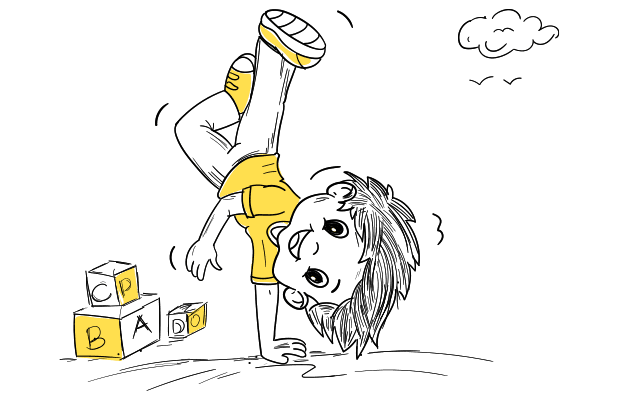Hyperactivity and sitting tolerance are two important aspects related to attention and behavior, particularly in children. Hyperactivity is characterized by excessive impulsive motor activity, often accompanied by an inability to stay still, or pay attention. On the other hand, sitting tolerance refers to an individual’s ability to remain seated and engaging in tasks for an appropriate duration, especially longer period of time. Both hyperactivity and poor sitting tolerance can significantly impact a child’s daily activities, especially in educational settings. This blog aims to delve into the definition of hyperactivity, methods for managing it, techniques to improve sitting tolerance, and the identification of symptoms related to hyperactivity.
Hyperactivity
Hyperactivity is commonly associated with Attention Deficit Hyperactivity Disorder (ADHD), though it can also manifest independently. Children with hyperactivity often display restless behavior, such as fidgeting, squirming and often act without thinking about the consequences. They find it challenging to sit still, frequently leave their seats when not expected, and struggle to engage in quiet activities. Hyperactive children may act impulsively, interrupt conversations, and have trouble waiting for their turn in games or activities. These symptoms significantly interfere with their daily functioning and may lead to problems in academic and social settings like maintaining friendships, adjustment issues etc.

Symptoms of hyperactivity
Symptoms of hyperactivity should persist for at least six months and be observed in multiple settings, such as home, school, or in social situations. Common signs of hyperactivity include:
1. Frequent fidgeting or squirming and restlessness, even in situations where it is inappropriate.
2. Difficulty remaining seated or roaming around when expected to sit in one place.
3. Often running, jumping or climbing uncontrollably, when it is not appropriate.
4. Difficulty waiting for their turns for longer period of time.
5. Difficulty engaging in quiet activities or tasks.
6. Showing risk taking behaviours.
7. Sometimes, physically harming others, etc.
Managing hyperactivity
Managing hyperactivity involves a comprehensive approach that may include behavioral interventions, lifestyle adjustments, and, in some cases, medication. Some effective techniques for controlling hyperactivity include:
A. Behavioral Therapy: Behavioral interventions can help children recognize and modify their impulsive behavior. This therapy encourages them to develop self-control and emotional regulation skills.
B. Family Support: Providing a structured environment at home and in school can help manage hyperactivity. Consistent routines, clear expectations, and positive reinforcement for appropriate behavior are essential.
C. Physical Activity: Engaging in regular physical activities can help channel excess energy and reduce hyperactivity. Exercises or any kind of physical activities like cycling, dancing, swimming etc has been shown to improve attention and reduce hyperactivity and impulsivity in children.
D. Mindfulness and Relaxation Techniques: Practicing mindfulness and relaxation exercises can teach children how to calm themselves and reduce impulsive behavior.
E. Medication: In severe cases of ADHD-related hyperactivity, stimulant medications may be prescribed by healthcare professionals. However, medication may also be a part of a comprehensive treatment plan, if required.
Techniques to improve sitting tolerance
Improving sitting tolerance is crucial for children who struggle to stay seated and focused for extended periods. This skill is particularly important in educational and work settings. Some techniques to enhance sitting tolerance include:
A. Gradual Increase in Sitting Time: For individuals with low sitting tolerance, gradually increasing the duration of seated activities can help build endurance over time.
B. Incorporating Movement Breaks: Allowing short, scheduled movement breaks during extended seated tasks can help individuals recharge and maintain focus.
C. Sensory Tools: Providing sensory tools like fidget toys or seating cushions can offer sensory input and help individuals stay seated more comfortably.
D. Task Modification: Breaking tasks into smaller chunks, manageable segments and providing clear instructions can make sitting activities less overwhelming.
E. Visual Supports: Visual aids or timers can be used to show the remaining time for sitting tasks, helping individuals pace themselves accordingly.
F. Calming activities: Practicing calm down yoga regularly may help reduce hyperactivity and improve sitting tolerance.
Hyperactivity and sitting tolerance are interconnected aspects of attention and behavior that significantly impact daily life, particularly in educational settings. Understanding the symptoms and causes of hyperactivity allows for effective control measures, such as behavioral interventions, support from parents and educators, and, when necessary, medication. Improving sitting tolerance through gradual exposure, movement breaks, and task modifications can also contribute to better functioning and focus. Identifying hyperactivity requires a comprehensive evaluation by qualified professionals to ensure appropriate intervention and support. By addressing hyperactivity and improving sitting tolerance, children can enhance their overall well-being and thrive in various aspects of life.


